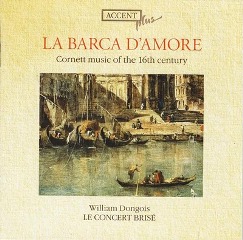La Barca d’Amore (2006)
La Barca d’Amore (2006)

1.Giacomo Gorzanis - La barca d'amore, galliarde for lute
2.Giovanni Bassano - Susanne un jour, diminution after Lassus
3.Anonymous, Italian - Pavane & Saltarello, for ensemble
4.Giovanni Della Casa - Jouissance vous donneray, diminution after Adrian Willaert
5.Pierre Attaingnant - Pavane - Galliarde No. 4
6.Giovanni Bassano - Vestiva i colli, diminution after Palestrina
7.Pierre Attaingnant - Pavane & sauterelle, for lute play
8.Giovanni Bassano - Mirami vita mia, diminution after Claudio Merulo
9.Giovanni Battista Fontana - Sonata Quarta
10.Giovanni Battista Bovicelli - Variations on Palestrina's "Io son ferito"
11Giovanni Battista Fontana - Sonata 6 per il violino o cornetto
12.Riccardo Rognoni - Anchor che col partire, for 2 instruments (after Cipriano de Rore) play
13.Giovanni Mealli - Sonata for violin & continuo, Op. 3/2 "La Cesta"
14.Riccardo Rognoni - Pulchra es amica mea, diminution
15.Benedetto Ferrari - Ciaconna for solo voice
William Dongois - cornett
Le Concert Brisé
This release by the historical-instrument group Le Concert Brisé (meaning the Broken Consort or consort with instruments from diverse families) originally appeared in 1997. The material remains unfamiliar, and the album was generally a good candidate for reissue. The presentation is not exactly user-friendly. The title "La barca d'amore" (The Boat of Love) comes from part of one of the dance pieces included and doesn't really give an indication of the flavor of the whole. What you get is sixteenth-century Italian virtuoso music for the Renaissance cornett, a tube-shaped (or snake-shaped) wind instrument that produces a sound somewhere between that of an oboe and a horn. It's difficult to play to begin with, and the performer here, William Dongois, delved into treatises and uncovered some of the instrument's improvisatory traditions. The result is some very exciting playing, an example of which can be heard in the Sonata seconda ("La cesta"), track 13. All of the music involves considerable ornamentation, and Dongois' notes don't make the procedures used totally clear. Much of his essay discusses the procedure known as division, a type of variation form that was partly left to the ingenuity of the player. The divisions here (not thus marked in the tracklist) are the pieces based on preexisting models, such as Jouissance vous donneray (track 4), with a model by Willaert elaborated by one G. dalla Casa. Other genres represented are sonatas, which at this point were instrumental analogues to the keyboard toccata, and dance pairs. All, according to Dongois, were vigorously ornamented, although the style would differ in each case. It requires a little work to figure out what's going on in the music, but it's enjoyable and smoothly done, and the album remains an important step in rescuing Renaissance instrumental music from the dry bones of its notated versions. ~ James Manheim, Rovi
download: uploaded yandex 4shared mediafire solidfiles mega filecloudio nornar ziddu
Last Updated (Thursday, 03 April 2014 19:46)








